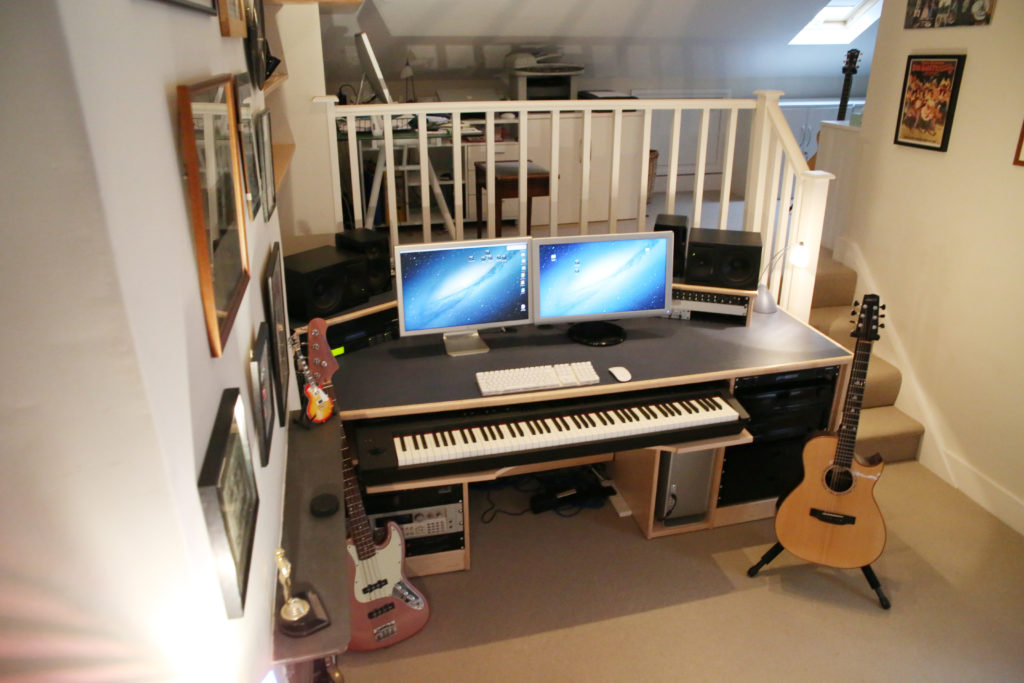I’ve been in the music business for quite a few years and it’s certainly had its ups and downs. I’ve been confused, insecure, unsure of my own ability as a writer and sometimes unable to climb those ‘steep stairs of doom’ to my roof top studio.
I started out as a new studio owner, buying a collection of magical, mysterious recording toys with absolutely no clue how it all worked. I discovered early on that plugging it in was an essential and necessary first step but all I got was a firework display of flashing lights and intriguing back-lit options telling me to proceed, whatever that meant?
Despite the reluctance to read any of the instruction manuals, a practice I still adhere to today, I managed to get things up and running and miraculously started creating random and serendipitous noises.
But there was always deep insecurity whether anything I wrote was any good. This was accompanied by total isolation with only the disjointed voices in my head and the fear of a client’s reassurance: “I’ll know it when I hear it”. I decided to limit my writing and studio activity to very specific areas in which I felt happy and secure.
I would use engineers when it came to recording singers. I had no idea about microphone positions, pop shields, compression or vocal levels.
I would use someone else to mix the tracks, especially commercials. We’d always been told to mix on small speakers to simulate crappy TV sound or small transistor radios and I remained paranoid that it would all sound pants when it was broadcast.
Mastering was a science that was so elusive it didn’t really feel like part of the process. Once all the parts had been recorded, we’d often stay up through the night, eating cold pizzas and very unsavoury Indian take-outs, building the impossible final mixes. No automation or ‘undo’ options. Just long pencils so we could grab several faders at once, many sticky hands on the innumerable knobs and a dozen or so rehearsals to get the coordinated faders in sync, only to get to the last ten seconds of the fade and the pencil would slip and we’d have to start again.
The next process was to take these masterpieces to a mastering facility, often run by the majors so we could cut the vinyl master and finally sign the project off. First in would have the luxury of physically scratching a credit or abusive note onto the master which would in turn be duplicated on every copy when pressed. After all that money, all we cared about was that small piece of childish graffiti that would be our personal legacy when people bought the thing!
Now, with automation, Digital work stations and unlimited undo options, it has reduced the process into a relatively dull and cold endeavour. Unless you are either very rich or totally bonkers you don’t master vinyl anymore.
Mixing and mastering tools seem to have blended into one transparent task so that even from the outset, you can decide exactly how you want the track or song to sound like before its completed.
We have myths and stupid opinions about volume and loudness and how much level you can actually glue to a product, especially with all the various platforms, streaming and the very likely scenario that we’re steering towards a future world where absolute deafness will be pandemic!
Having experienced first-hand and still continue to sail through this swamp of meaningless endeavours, I decided that I would throw caution to the wind and offer a slightly different approach. Under the hashtag; ‘What would this sound like without the bass, drums, strings etc?’ I decided to offer alternative mixes to every track in the Topline music library. First, the original mix. Then, how many variations could I get from the one track? Rather than ask someone else for these, I decided to go ahead and mix them in different ways myself, sometimes finding that the sixth mix for example was better than the first. The conclusion to this process meant that we could offer so much more out of any individual track.
Check this one for example which is a song that not only offers the original mix but several additional versions.
Also, here with the original instrumental and then several other mixes built around the same piece.
It’s amazing, liberating and has certainly given me a new lease on production and the process of letting a track go.
Remember, you have the controls; Mix, master, finish and let go and just see what happens. And most important, enjoy the process, believe in your ability and love what you write. Most of the time, you’ll be the only one who does!


